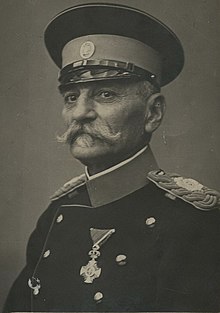
Back Petrus I Serba Cyning ANG بيتر الأول ملك صربيا Arabic بيتر الاول ملك صربيا ARZ بیرینجی پتر (صربیستان) AZB Пётр I Карагеоргіевіч Byelorussian Петър I Караджорджевич Bulgarian Petar I, kralj Srbije BS Pere I de Sèrbia Catalan Petr I. Karađorđević Czech Peter 1. af Jugoslavien Danish
| Peter I Петар I Карађорђевић | |
|---|---|
 King Peter in 1904 | |
| King of the Serbs, Croats and Slovenes | |
| Reign | 1 December 1918 – 16 August 1921 |
| Successor | Alexander I Karađorđević |
| Regent | Alexander (1918–1921) |
| King of Serbia | |
| Reign | 15 June 1903 – 1 December 1918 |
| Coronation | 21 September 1904 |
| Predecessor | Alexander I Obrenović |
| Regent | Alexander (1914–1918) |
| Born | 11 July [O.S. 29 June] 1844 Belgrade, Serbia |
| Died | 16 August 1921 (aged 77) Belgrade, Kingdom of Serbs, Croats and Slovenes |
| Burial | |
| Spouse | |
| Issue |
|
| House | Karađorđević |
| Father | Alexander Karađorđević, Prince of Serbia |
| Mother | Persida Nenadović |
| Religion | Serbian Orthodox |
| Signature |  |
| Military career | |
| Allegiance | |
| Years of service | 1855–58 (end of active service) |
| Rank | Vojvoda (Field marshal) |
| Battles/wars | Herzegovina uprising (1875–1877) First Balkan War Second Balkan War World War I Koplik War |
| Styles of Peter I of Yugoslavia | |
|---|---|
 | |
| Reference style | His Majesty |
| Spoken style | Your Majesty |
Peter I (Serbian Cyrillic: Петар I Карађорђевић, romanized: Petar I Кarađorđević; 11 July [O.S. 29 June] 1844 – 16 August 1921) was King of Serbia from 15 June 1903 to 1 December 1918. On 1 December 1918, he became King of the Serbs, Croats and Slovenes, and he held that title until his death three years later. Since he was the king of Serbia during a period of great Serbian military success, he was remembered by Serbians as King Peter the Liberator and also as the Old King.
Peter was the fifth child and third son of Alexander Karađorđević, Prince of Serbia, and his wife, Persida Nenadović. Prince Alexander was forced to abdicate in 1858, and Peter lived with his family in exile. He fought with the French Foreign Legion in the Franco-Prussian War. He joined as a volunteer under the alias Peter Mrkonjić (Serbian Cyrillic: Петар Мркоњић, romanized: Petar Mrkonjić) in the Herzegovina uprising (1875–1877) against the Ottoman Empire. In 1883, Prince Peter married Princess Ljubica, daughter of King Nicholas I of Montenegro. Ljubica became known as Princess Zorka upon her marriage. Peter and Zorka had five children: Helen, Milena, George, Alexander, and Andrew. After his father died in 1885, Peter became head of the Karađorđević dynasty.
After King Alexander I Obrenović was murdered during the May Coup of 1903, Peter Karađorđević became the new king of Serbia. As king, he advocated a constitutional setup for the country and was famous for his liberal politics. Peter's rule was marked with the great exercise of political liberties, freedom of the press, national, economical and cultural rise, and it is sometimes dubbed a "golden" or "Periclean age".[1] Peter was the supreme commander of the Royal Serbian Army in the Balkan Wars. On 24 June 1914, the aging king proclaimed his son and heir Alexander as regent. In World War I, the King and his army retreated across the Principality of Albania. Peter died in 1921 aged 77.
- ^ Bataković, Dušan (2017). "On Parliamentary Democracy in Serbia 1903–1914 Political Parties, Elections, Political Freedoms". Balcanica (XLVIII): 123–142. doi:10.2298/BALC1748123B.
© MMXXIII Rich X Search. We shall prevail. All rights reserved. Rich X Search